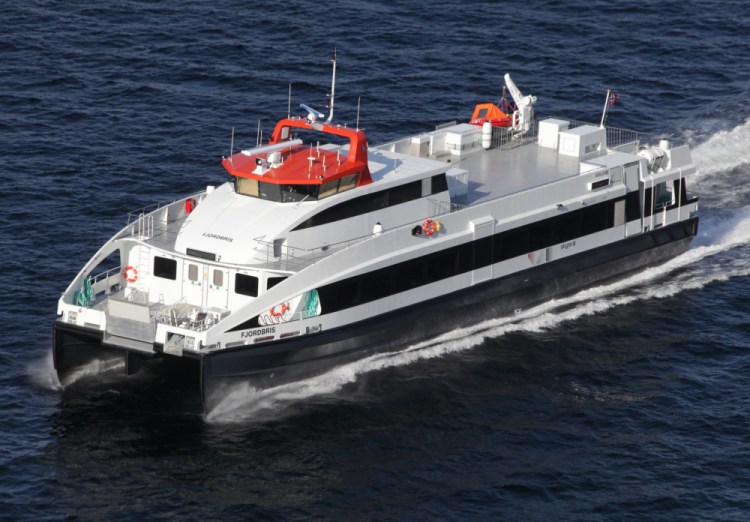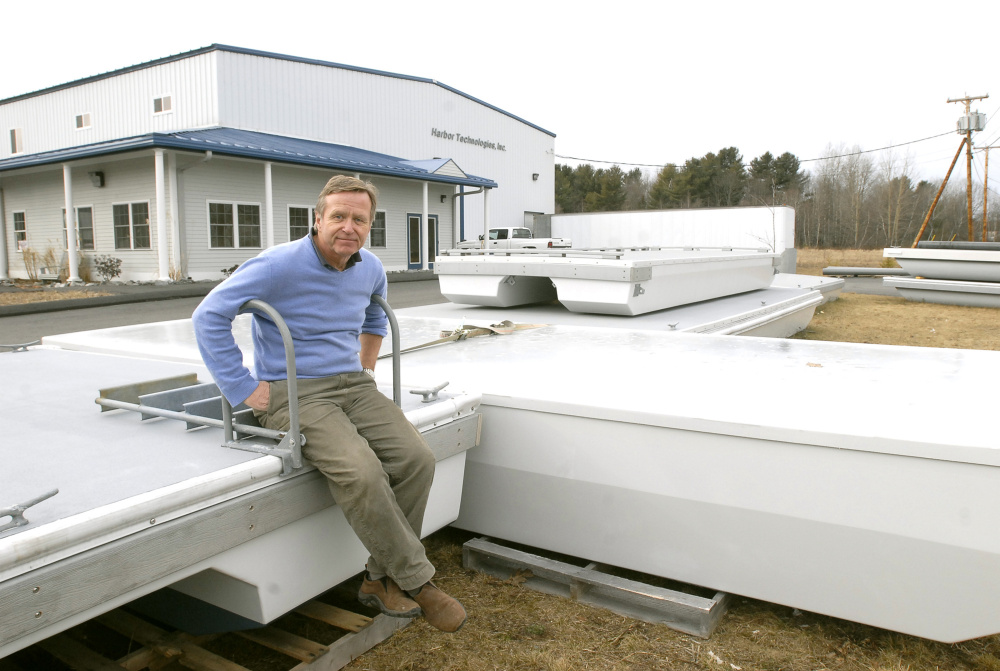Front Street Shipyard in Belfast and a Norwegian shipbuilder are close to completing a joint venture agreement that would make Front Street the only U.S. manufacturer of high-speed, carbon-fiber ferries, and bring 50 to 100 jobs to the midcoast area.
J.B. Turner, Front Street’s president, has signed a memorandum of understanding to collaborate on a joint venture with Brødrene Aa, a shipyard in Norway that has been building high-speed, carbon-fiber ferries for several years. Under the agreement, Front Street would build the high-tech vessels in Belfast using the Norwegian company’s designs and expertise.
The operation will focus on the U.S. segment of an international ferry market that has been estimated to be worth $15 billion. Turner said the ferries would be like those providing service between New York City and New Jersey, and Long Island, New York, and Connecticut.
“From my point of view, we’re trying to look at diversification wherever possible in the marine industry,” Turner said. “And we’re set up for that. We have the facilities to do it. We have the technological know how to do it. We have all the systems, the people. … It all makes sense, so why not go down that road?”
The ferries Front Street is expecting to build would be between 100 feet and 130 feet long. The company intends to focus initially on passenger-only ferries that carry up to 150 people, which need to meet less-stringent Coast Guard standards than larger ferries that carry more passengers or cars, Turner said.
Front Street now employs slightly more than 100 people; building ferries could add 50 to 100 jobs, he said.
And the economic impact would be felt beyond Front Street’s shipyard.
“When you build a vessel like that, the whole Maine composites industry will benefit, as well as beyond that for components needed for that vessel,” said Martin Grimnes, who has founded two composite manufacturing companies in Maine since the 1980s and brought the parties to the negotiating table. He estimated that the type of ferries Front Street is talking about would cost between $5 million and $10 million to build.
Every summer since the late 1970s, Grimnes and his wife have taken the ferry from Rockland to Vinalhaven, where his wife’s family has a summer place. And every time he’d take the trip on a steel-hulled ferry, he’d wonder why no shipyard in Maine was building passenger ferries out of the lightweight composite materials he has worked with for the majority of his career.
“That’s been burning on my mind for 40 years,” Grimnes said. “I’ve been saying not only that they should be built in Maine, but built with composites and not 1960s technology.”
Grimnes has been a colleague of Turner’s for years. They’ve often talked of the advantages of composites in marine uses. Ships built with composite materials – like fiberglass or carbon fiber – are lighter than those with steel hulls, which improves fuel efficiency and reduces maintenance costs since composite materials don’t corrode, Grimnes said. There’s a reason the world’s fastest sailboats are built with composites and not steel.
The talk turned into action this year after the Maine Composites Alliance received a grant from the Maine Technology Institute to do market research into the possibility of building composite ferries in Maine. The research included exploring what type of U.S. Coast Guard codes would need to be met to build a passenger ferry out of carbon fiber, something no one in the country has yet done, according to Turner.
While they were working on that, Grimnes, who was born in Norway but has lived in Maine since the 1970s, leveraged his connections in the global boat building and composite industries to put Turner in touch with Brødrene Aa. Turner’s interest was piqued, and he flew to Norway over the summer with one of his designers to visit the shipyard.
“You can talk back and forth all you want,” Turner said. “I’m not much for talking. I’d rather do.”
Located on a fjord in the Norwegian town of Hyen, Brødrene Aa has been building ships since 1947. The shipyard built passenger ferries in wood before transitioning to composites in the mid-70s. In the early 2000s, the company started using carbon fiber to build high-speed ferries. Turner was impressed with the company, its philosophy and its shipyard, which employs nearly the same number of people as Front Street.
“We started thinking, ‘This might actually work,'” he said.
Not long after returning to Maine, Turner and Brødrene Aa signed the memorandum of understanding, which they call the Arcadia Alliance.
A player in Maine’s composites sector, Grimnes founded Harbor Technologies, a manufacturer of composites construction components like beams, in Brunswick in 2003. In November, he sold the assets of that company to Kenway Corp., another composites-based manufacturer, which owns 20 percent of Front Street Shipyard. Grimnes’ role in the joint venture is as yet undetermined
From Brødrene Aa’s perspective, the joint venture will give it a toehold in the lucrative U.S. ferry market, according to Ole Andre Aa, an engineer who leads the Norwegian shipyard’s sales and marketing effort. Per federal law, any commercial vessels operating within the United States, from lobster boats to passenger ferries, need to be built in the United States. This effectively meant the market was off limits to Brødrene Aa.
“The U.S. market is a very big market,” said Ole Andre Aa. “There are few countries in the world with more high-speed ferries. But because of the Jones Act, it is very hard for Brødrene Aa to enter the market.”
Aa joined a contingent that visited Maine last month to tour Front Street and meet with Turner.
“I think it’s a very good match because the Front Street Shipyard employees are very good boatbuilders and they know composites very well,” Aa said. “We were very impressed by what we saw.”
The last passenger ferry built in Maine was the Emerald Isle, a 130-foot ship built by Washburn and Doughty in East Boothbay and launched in November 1997, according to Jon Johansen, president of Maine Built Boats. It was delivered to Beaver Island in Lake Michigan.
Johansen said Front Street’s new venture would cement Maine as a place where innovation happens in shipbuilding. Ever since the days of clipper ships, Maine shipyards have introduced innovative technology and designs in the shipbuilding industry, he said.
“Technologically, we’ve always been sort of on the forefront,” Johansen said.
Turner said he hopes to have the first ferry under construction in 2016.
Send questions/comments to the editors.




Comments are no longer available on this story